Mechanical Properties of Fiber-Reinforced High-Volume Fly-Ash-Based Cement Composite—A Long-Term Study
Abstract
:1. Introduction
1.1. Factors Affecting Mechanical Properties of Concrete
1.2. Effect of Pozzolans on Mechanical Properties of Concrete
1.3. Effect of PPF on Mechanical Properties of Concrete and Composites
2. Research Significance
3. Materials and Methods
3.1. Material Characteristics and Mix Proportioning
3.2. Testing Parameters
3.2.1. Compression Test
3.2.2. Ultrasonic Pulse Velocity Test
3.2.3. Flexural Strength Test
3.2.4. Splitting Tensile Strength Test
3.2.5. Bond Strength (Pull-Out) Test
3.2.6. Sorptivity
3.2.7. Morphology
4. Results and Discussion
4.1. Compressive Strength
4.2. UPV Test
4.3. Flexural Strength Test
4.4. Splitting Tensile Strength Test
4.5. Bond Strength
4.6. Sorptivity
4.7. Failure Patterns
4.7.1. Compressive Strength Test
4.7.2. Flexural Strength Test
4.7.3. Splitting Tensile Strength Test
4.7.4. Bond Strength (Pull-Out) Test
4.8. Microstructure Analysis of the Sample
5. Conclusions
- The addition of PPF, irrespective of volume fraction, does not improve compressive strength. The gain in compressive strength is ceaseless for both immersion and moist-cured samples. The persistent increase in weight, hydration, and resulting microstructure refinement are credited for this strength gain. The UPV test affirms the quality of all the mixes.
- The mixes with PPF display remarkable improvement in the tensile strength to compressive strength due to the ‘bridging’ of the crack and delay in propagation, improving the tensile capacity. The increase in the tensile strength corresponds to an increase in the volume fraction of PPF. However, the composite’s flexural strength trend differs from the splitting tensile strength. The PPF0.6 mix achieves the highest flexural strength compared to the other PPF mixes.
- The PPF0 mix fails catastrophically due to the ‘brittle’ nature of the high-paste-containing composite. Adding PPF, irrespective of the volume fractions, is significant in achieving a more ductile failure under compression stresses. The PPF also significantly improves the resistance to spalling of the composite.
- The improvement in the bond strength of the plain composite is ascribed to the continuous hydration by forming C-S-H, refining the microstructure, and increasing the adhesion between the reinforcement and the paste. Adding PPF to the mix improves the bond strength of the composite.
- The water absorption of the composite varies inversely with the addition of PPF. The composite’s initial and secondary water absorption rate (sorptivity) significantly reduces with the increase in the volume fraction of PPF, demonstrating the excellent durability of the composite.
- The microstructure of PPF0 continuously refines with age. The presence of F-FA in large amounts in the composite not only contributes to the hydration but also acts as a filler refining the pore to evince the purpose of the composite mixture.
Author Contributions
Funding
Institutional Review Board Statement
Informed Consent Statement
Data Availability Statement
Acknowledgments
Conflicts of Interest
References
- Sobolev, K. Sustainable Development of the Cement Industry and Blended Cements to Meet Ecological Challenges. Sci. World J. 2003, 3, 308–318. [Google Scholar] [CrossRef] [PubMed]
- Tirth, V. Greenhouse Gas Emissions Due to the Construction of Residential Buildings in Moradabad, India. Appl. Ecol. Environ. Res. 2019, 17, 12111–12126. [Google Scholar] [CrossRef]
- Sharp, J.H. Surely We Know All about Cement—Don’t We? Adv. Appl. Ceram. 2006, 105, 162–174. [Google Scholar] [CrossRef]
- Ganesh, A.C.; Muthukannan, M. Development of High Performance Sustainable Optimized Fiber Reinforced Geopolymer Concrete and Prediction of Compressive Strength. J. Clean. Prod. 2021, 282, 124543. [Google Scholar] [CrossRef]
- Liu, Z.; Takasu, K.; Koyamada, H.; Suyama, H. A Study on Engineering Properties and Environmental Impact of Sustainable Concrete with Fly Ash or GGBS. Constr. Build. Mater. 2022, 316, 125776. [Google Scholar] [CrossRef]
- Laxman Kudva, P.; Nayak, G.; Shetty, K.K.; Sugandhini, H.K. A Sustainable Approach to Designing High Volume Fly Ash Concretes. Mater. Today Proc. 2022, 65, 1138–1145. [Google Scholar] [CrossRef]
- CEA Ministry of Power Government of India. CEA Annual Report 2021-22. 2022. Available online: https://cea.nic.in/wp-content/uploads/annual_reports/2022/AR_2021_22_dated_03.11.2022.pdf (accessed on 28 November 2022).
- Hemalatha, T.; Ramaswamy, A. A Review on Fly Ash Characteristics—Towards Promoting High Volume Utilization in Developing Sustainable Concrete. J. Clean. Prod. 2017, 147, 546–559. [Google Scholar] [CrossRef]
- Na, L. ACI 318M-11 Building Code Requirements for Structural Concrete (ACI 318M-11) and Commentary; ACI: Farmington Hills, MI, USA, 2011. [Google Scholar]
- Karimi Pour, A.; Mohajeri, Z.; Noroozinejad Farsangi, E. Impact of Polypropylene Fibers on the Mechanical and Durability Characteristics of Rubber Tire Fine Aggregate Concrete. Materials 2022, 15, 8043. [Google Scholar] [CrossRef]
- Yoo, S.-W.; Ryu, G.-S.; Choo, J.F. Evaluation of the Effects of High-Volume Fly Ash on the Flexural Behavior of Reinforced Concrete Beams. Constr. Build. Mater. 2015, 93, 1132–1144. [Google Scholar] [CrossRef]
- Weerasinghe, A.S.; Ramachandra, T.; Rotimi, J.O.B. Comparative Life-Cycle Cost (LCC) Study of Green and Traditional Industrial Buildings in Sri Lanka. Energy Build. 2021, 234, 110732. [Google Scholar] [CrossRef]
- Hasan, N.M.; Sobuz, M.H.; Khan, M.M.; Mim, N.J.; Meraz, M.M.; Datta, S.D.; Rana, M.J.; Saha, A.; Akid, A.S.; Mehedi, M.T.; et al. Integration of Rice Husk Ash as Supplementary Cementitious Material in the Production of Sustainable High-Strength Concrete. Materials 2022, 15, 8171. [Google Scholar] [CrossRef] [PubMed]
- Sobuz, M.H.R.; Datta, S.D.; Akid, A.S.M. Investigating the Combined Effect of Aggregate Size and Sulphate Attack on Producing Sustainable Recycled Aggregate Concrete. Aust. J. Civ. Eng. 2022, 1–16. [Google Scholar] [CrossRef]
- Sobuz, M.H.R.; Datta, S.D.; Rahman, M. Evaluating the Properties of Demolished Aggregate Concrete with Non-Destructive Assessment. In Advances in Civil Engineering; Arthur, S., Saitoh, M., Pal, S.K., Eds.; Lecture Notes in Civil, Engineering; Springer: Singapore, 2022; Volume 184, pp. 223–233. ISBN 9789811655463. [Google Scholar]
- Sobuz, M.H.R.; Datta, S.D.; Akid, A.S.M.; Tam, V.W.Y.; Islam, S.; Rana, M.J.; Aslani, F.; Yalçınkaya, Ç.; Sutan, N.M. Evaluating the Effects of Recycled Concrete Aggregate Size and Concentration on Properties of High-Strength Sustainable Concrete. J. King Saud Univ. Eng. Sci. 2022, in press. [Google Scholar] [CrossRef]
- Siddique, R.; Aggarwal, P.; Aggarwal, Y. Influence of Water/Powder Ratio on Strength Properties of Self-Compacting Concrete Containing Coal Fly Ash and Bottom Ash. Constr. Build. Mater. 2012, 29, 73–81. [Google Scholar] [CrossRef]
- Irrational Concrete with Rational Performance. Available online: https://fal-g.com/wp-content/uploads/2022/05/Press-Note-on-Concrete-without-C.Ag-180110.pdf (accessed on 28 November 2022).
- Prem, P.R.; Bharatkumar, B.H.; Iyer, N.R. Influence of Curing Regimes on Compressive Strength of Ultra High Performance Concrete. Sadhana 2013, 38, 1421–1431. [Google Scholar] [CrossRef]
- Verma, N.; Misra, A.K. Bond Characteristics of Reinforced TMT Bars in Self Compacting Concrete and Normal Cement Concrete. Alex. Eng. J. 2015, 54, 1155–1159. [Google Scholar] [CrossRef]
- Bediako, M.; Kevern, J.T.; Amankwah, E.O. Effect of Curing Environment on the Strength Properties of Cement and Cement Extenders. Mater. Sci. Appl. 2015, 06, 33–39. [Google Scholar] [CrossRef]
- Röβler, M.; Odler, I. Investigations on the Relationship between Porosity, Structure and Strength of Hydrated Portland Cement Pastes I. Effect of Porosity. Cem. Concr. Res. 1985, 15, 320–330. [Google Scholar] [CrossRef]
- Odler, I.; Rößler, M. Investigations on the Relationship between Porosity, Structure and Strength of Hydrated Portland Cement Pastes. II. Effect of Pore Structure and of Degree of Hydration. Cem. Concr. Res. 1985, 15, 401–410. [Google Scholar] [CrossRef]
- Yuan, Z.; Jia, Y. Mechanical Properties and Microstructure of Glass Fiber and Polypropylene Fiber Reinforced Concrete: An Experimental Study. Constr. Build. Mater. 2021, 266, 121048. [Google Scholar] [CrossRef]
- Liu, B.; Xie, Y.; Zhou, S.; Yuan, Q. Influence of Ultrafine Fly Ash Composite on the Fluidity and Compressive Strength of Concrete. Cem. Concr. Res. 2000, 30, 1489–1493. [Google Scholar] [CrossRef]
- Tangpagasit, J.; Cheerarot, R.; Jaturapitakkul, C.; Kiattikomol, K. Packing Effect and Pozzolanic Reaction of Fly Ash in Mortar. Cem. Concr. Res. 2005, 35, 1145–1151. [Google Scholar] [CrossRef]
- Kumar, M.; Sinha, A.K.; Kujur, J. Mechanical and Durability Studies on High-Volume Fly-Ash Concrete. Struct. Concr. 2021, 22, E1036–E1049. [Google Scholar] [CrossRef]
- Chindaprasirt, P.; Jaturapitakkul, C.; Sinsiri, T. Effect of Fly Ash Fineness on Compressive Strength and Pore Size of Blended Cement Paste. Cem. Concr. Compos. 2005, 27, 425–428. [Google Scholar] [CrossRef]
- Chindaprasirt, P.; Rukzon, S. Strength, Porosity and Corrosion Resistance of Ternary Blend Portland Cement, Rice Husk Ash and Fly Ash Mortar. Constr. Build. Mater. 2008, 22, 1601–1606. [Google Scholar] [CrossRef]
- Chandru, P.; Karthikeyan, J.; Sahu, A.K.; Sharma, K.; Natarajan, C. Performance Evaluation between Ternary Blended SCC Mixes Containing Induction Furnace Slag and Crushed Stone as Coarse Aggregate. Constr. Build. Mater. 2021, 267, 120953. [Google Scholar] [CrossRef]
- Deb, S.; Mitra, N.; Majumder, S.B.; Maitra, S. Improvement in Tensile and Flexural Ductility with the Addition of Different Types of Polypropylene Fibers in Cementitious Composites. Constr. Build. Mater. 2018, 180, 405–411. [Google Scholar] [CrossRef]
- Afroughsabet, V.; Ozbakkaloglu, T. Mechanical and Durability Properties of High-Strength Concrete Containing Steel and Polypropylene Fibers. Constr. Build. Mater. 2015, 94, 73–82. [Google Scholar] [CrossRef]
- Leong, G.W.; Mo, K.H.; Loh, Z.P.; Ibrahim, Z. Mechanical Properties and Drying Shrinkage of Lightweight Cementitious Composite Incorporating Perlite Microspheres and Polypropylene Fibers. Constr. Build. Mater. 2020, 246, 118410. [Google Scholar] [CrossRef]
- Pakravan, H.R.; Ozbakkaloglu, T. Synthetic Fibers for Cementitious Composites: A Critical and in-Depth Review of Recent Advances. Constr. Build. Mater. 2019, 207, 491–518. [Google Scholar] [CrossRef]
- Fu, Q.; Xu, W.; Bu, M.; Guo, B.; Niu, D. Effect and Action Mechanism of Fibers on Mechanical Behavior of Hybrid Basalt-Polypropylene Fiber-Reinforced Concrete. Structures 2021, 34, 3596–3610. [Google Scholar] [CrossRef]
- Karahan, O.; Atiş, C.D. The Durability Properties of Polypropylene Fiber Reinforced Fly Ash Concrete. Mater. Des. 2011, 32, 1044–1049. [Google Scholar] [CrossRef]
- Ghazy, A.; Bassuoni, M.; Maguire, E.; O’Loan, M. Properties of Fiber-Reinforced Mortars Incorporating Nano-Silica. Fibers 2016, 4, 6. [Google Scholar] [CrossRef]
- Ramezanianpour, A.A.; Esmaeili, M.; Ghahari, S.A.; Najafi, M.H. Laboratory Study on the Effect of Polypropylene Fiber on Durability, and Physical and Mechanical Characteristic of Concrete for Application in Sleepers. Constr. Build. Mater. 2013, 44, 411–418. [Google Scholar] [CrossRef]
- Das, C.S.; Dey, T.; Dandapat, R.; Mukharjee, B.B.; Kumar, J. Performance Evaluation of Polypropylene Fibre Reinforced Recycled Aggregate Concrete. Constr. Build. Mater. 2018, 189, 649–659. [Google Scholar] [CrossRef]
- Sivakumar, A.; Santhanam, M. Mechanical Properties of High Strength Concrete Reinforced with Metallic and Non-Metallic Fibres. Cem. Concr. Compos. 2007, 29, 603–608. [Google Scholar] [CrossRef]
- Jiang, C.; Fan, K.; Wu, F.; Chen, D. Experimental Study on the Mechanical Properties and Microstructure of Chopped Basalt Fibre Reinforced Concrete. Mater. Des. 2014, 58, 187–193. [Google Scholar] [CrossRef]
- Tian, H.; Zhang, Y.X. Ageing Effect on Tensile and Shrinkage Behaviour of New Green Hybrid Fibre-Reinforced Cementitious Composites. Cem. Concr. Compos. 2017, 75, 38–50. [Google Scholar] [CrossRef]
- Zeyad, A.M.; Khan, A.H.; Tayeh, B.A. Durability and Strength Characteristics of High-Strength Concrete Incorporated with Volcanic Pumice Powder and Polypropylene Fibers. J. Mater. Res. Technol. 2020, 9, 806–818. [Google Scholar] [CrossRef]
- Sohaib, N.; Mamoon, R.; Sana, G.; Seemab, F. Using Polypropylene Fibers in Concrete to Achieve Maximum Strength. In Proceedings of the Eighth International Conference On Advances in Civil and Structural Engineering—CSE 2018, Institute of Research Engineers and Doctors, Kuala Lumpur, Malaysia, 3–4 February 2018; pp. 37–42. [Google Scholar]
- Najimi, M.; Farahani, F.M.; Pourkhorshidi, A. Effects of Polypropylene Fibers on Physical and Mechanical Properties of Concretes. In Proceedings of the Third International Conference on Concrete and Development, Tehran, Iran, 27 April 2009; pp. 1073–1081. [Google Scholar]
- Kakooei, S.; Akil, H.M.; Jamshidi, M.; Rouhi, J. The Effects of Polypropylene Fibers on the Properties of Reinforced Concrete Structures. Constr. Build. Mater. 2012, 27, 73–77. [Google Scholar] [CrossRef]
- Bagherzadeh, R.; Pakravan, H.R.; Sadeghi, A.-H.; Latifi, M.; Merati, A.A. An Investigation on Adding Polypropylene Fibers to Reinforce Lightweight Cement Composites (LWC). J. Eng. Fibers Fabr. 2012, 7, 155892501200700. [Google Scholar] [CrossRef]
- Kan, L.; Shi, R.; Zhu, J. Effect of Fineness and Calcium Content of Fly Ash on the Mechanical Properties of Engineered Cementitious Composites (ECC). Constr. Build. Mater. 2019, 209, 476–484. [Google Scholar] [CrossRef]
- Lin, J.-X.; Song, Y.; Xie, Z.-H.; Guo, Y.-C.; Yuan, B.; Zeng, J.-J.; Wei, X. Static and Dynamic Mechanical Behavior of Engineered Cementitious Composites with PP and PVA Fibers. J. Build. Eng. 2020, 29, 101097. [Google Scholar] [CrossRef]
- Małek, M.; Łasica, W.; Kadela, M.; Kluczyński, J.; Dudek, D. Physical and Mechanical Properties of Polypropylene Fibre-Reinforced Cement–Glass Composite. Materials 2021, 14, 637. [Google Scholar] [CrossRef]
- Mohebi, Z.H.; Bahnamiri, A.B.; Dehestani, M. Effect of Polypropylene Fibers on Bond Performance of Reinforcing Bars in High Strength Concrete. Constr. Build. Mater. 2019, 215, 401–409. [Google Scholar] [CrossRef]
- Arezoumandi, M.; Looney, T.J.; Volz, J.S. Effect of Fly Ash Replacement Level on the Bond Strength of Reinforcing Steel in Concrete Beams. J. Clean. Prod. 2015, 87, 745–751. [Google Scholar] [CrossRef]
- Looney, T.J.; Arezoumandi, M.; Volz, J.S.; Myers, J.J. An Experimental Study on Bond Strength of Reinforcing Steel in High-Volume Fly-Ash Concrete. Adv. Civ. Eng. Mater. 2012, 1, 20120026. [Google Scholar] [CrossRef]
- IS 4031-1; Methods of Physical Tests for Hydraulic Cement, Part 1: Determination of Fineness by Dry Sieving. Bureau of Indian Standards: New Delhi, India, 1996.
- IS 4031-4; Methods of Physical Tests for Hydraulic Cement, Part 4: Determination of Consistency of Standard Cement Paste. Bureau of Indian Standards: New Delhi, India, 1988.
- IS 4031-11; Methods of Physical Tests for Hydraulic Cement, Part 11: Determination of Density. Bureau of Indian Standards: New Delhi, India, 1988.
- IS 4031-5; Methods of Physical Tests for Hydraulic Cement, Part 5: Determination of Initial and Final Setting Times. Bureau of Indian Standards: New Delhi, India, 1988.
- IS 4031-6; Methods of Physical Tests for Hydraulic Cement, Part 6: Determination of Compressive Strength of Hydraulic Cement (Other than Masonry Cement). Bureau of Indian Standards: New Delhi, India, 1988.
- IS 1727; Methods of Test for Pozzolanic Materials. Bureau of Indian Standards: New Delhi, India, 1967.
- IS 3812-1; Specification for Pulverized Fuel Ash, Part 1: For Use as Pozzolana in Cement, Cement Mortar and Concrete. Bureau of Indian Standards: New Delhi, India, 2003.
- IS 516; Method of Tests for Strength of Concrete. Bureau of Indian Standards: New Delhi, India, 1959.
- IS 516-5; Non-Destructive Testig of Concrete Section 1 Ultrasonic Pulse Velocity Testing. Bureau of Indian Standards: New Delhi, India, 2018.
- IS 5816; Method of Test Splitting Tensile Strength of Concrete. Bureau of Indian Standards: New Delhi, India, 1999.
- IS 2770-1; Methods of Testing Bond in Reinforced Concrete, Part 1: Pull-Out Test. Bureau of Indian Standards: New Delhi, India, 1967.
- Standard Test Method for Measurement of Rate of Absorption of Water by Hydraulic-Cement Concretes. Available online: https://www.astm.org/c1585-20.html (accessed on 30 July 2023).
- Sadeghi Nik, A.; Lotfi Omran, O. Estimation of Compressive Strength of Self-Compacted Concrete with Fibers Consisting Nano-SiO2 Using Ultrasonic Pulse Velocity. Constr. Build. Mater. 2013, 44, 654–662. [Google Scholar] [CrossRef]
- Mashrei, M.A.; Sultan, A.A.; Mahdi, A.M. Effects of Polypropylene Fibers on Compressive and Flexural Strength of Concrete Material. Int. J. Civ. Eng. Technol. 2018, 9, 2208–2217. [Google Scholar]


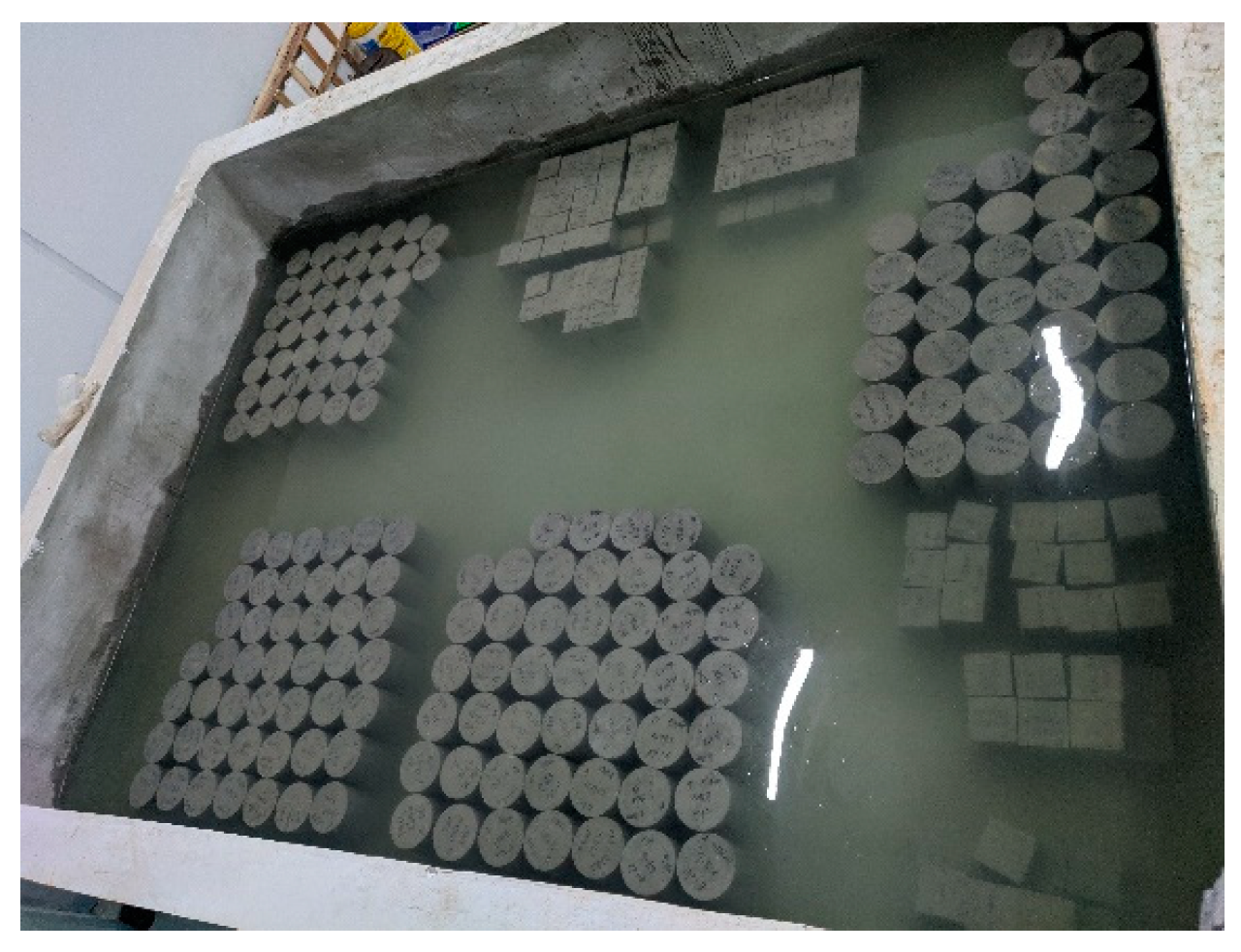

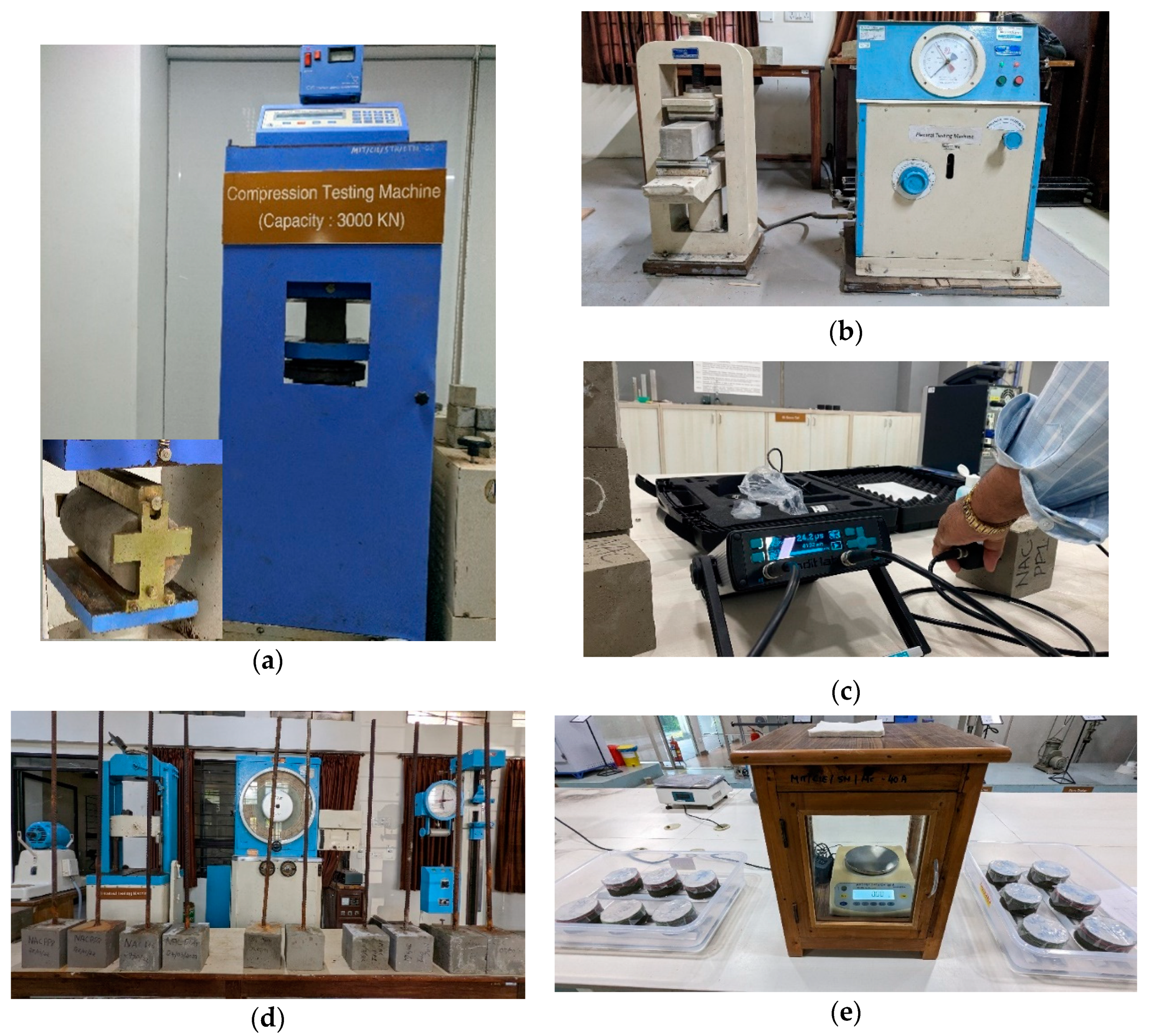

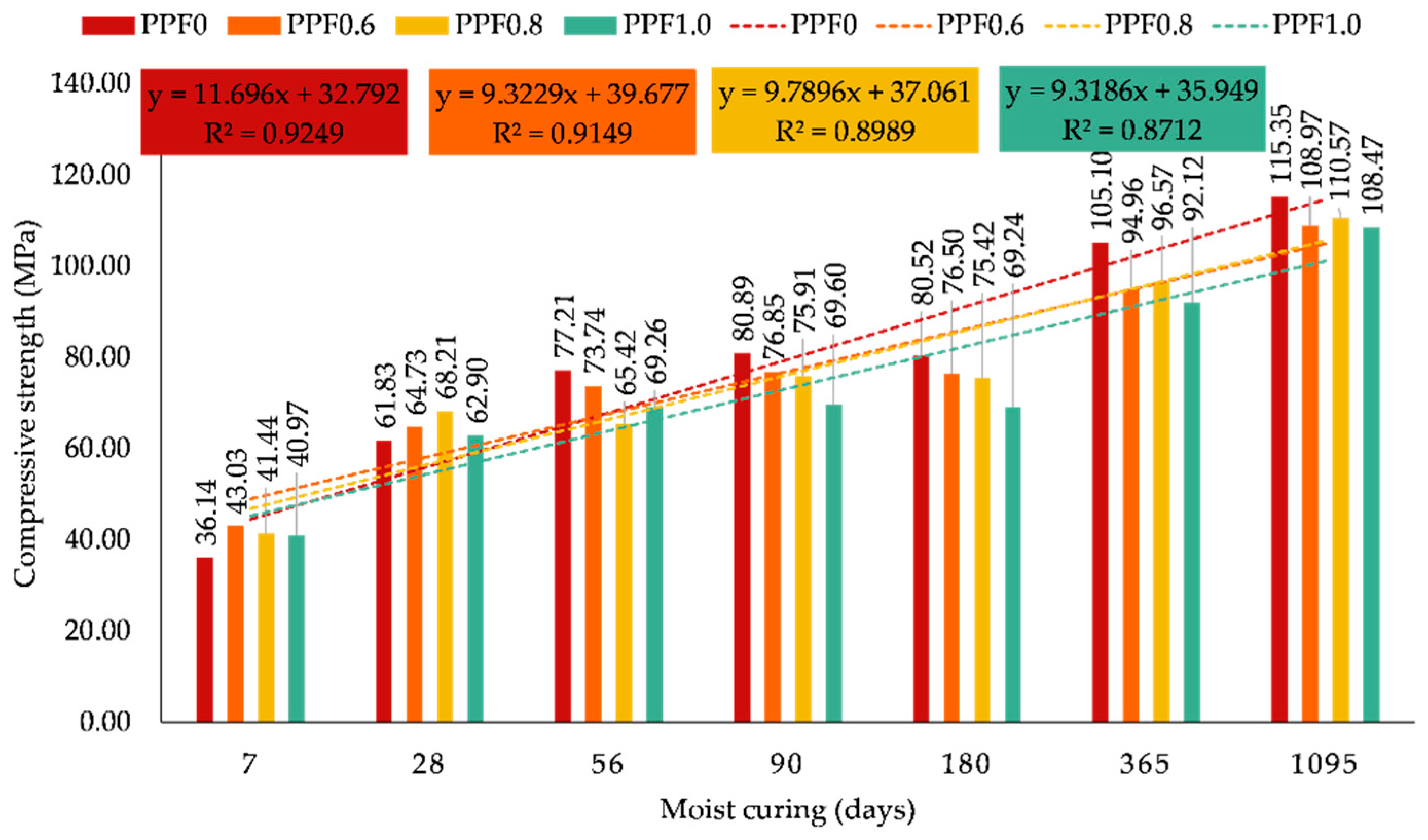
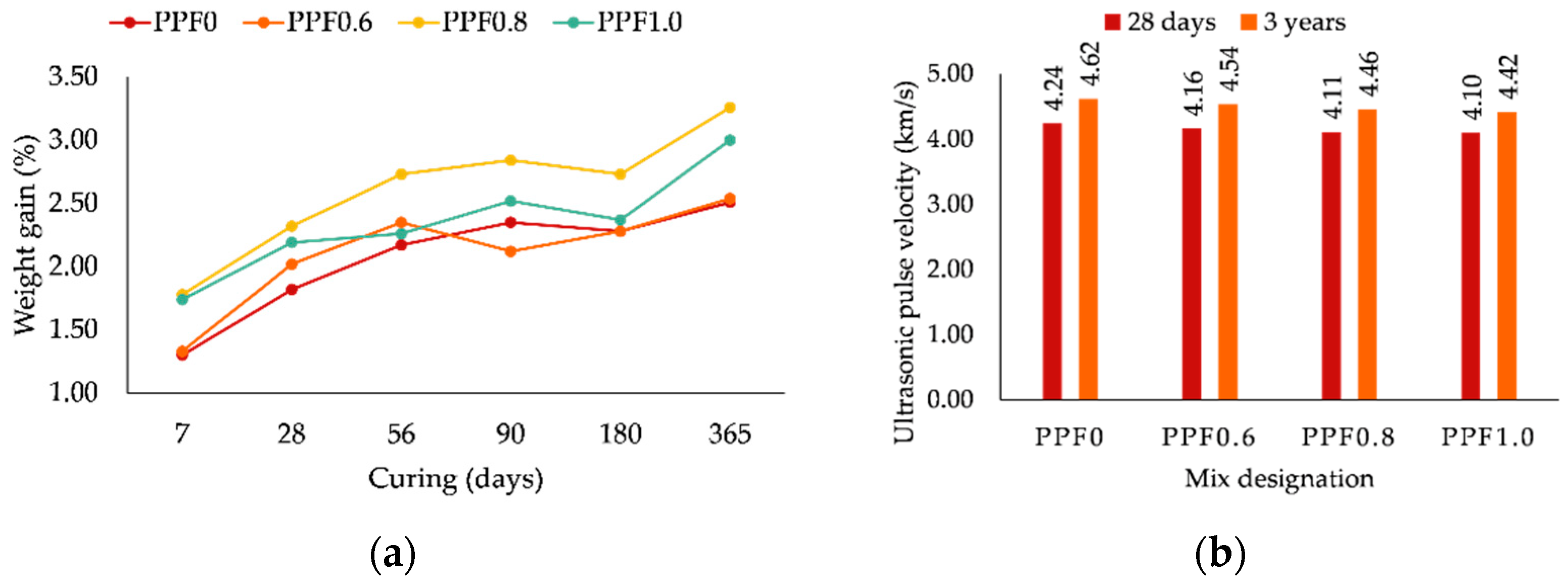

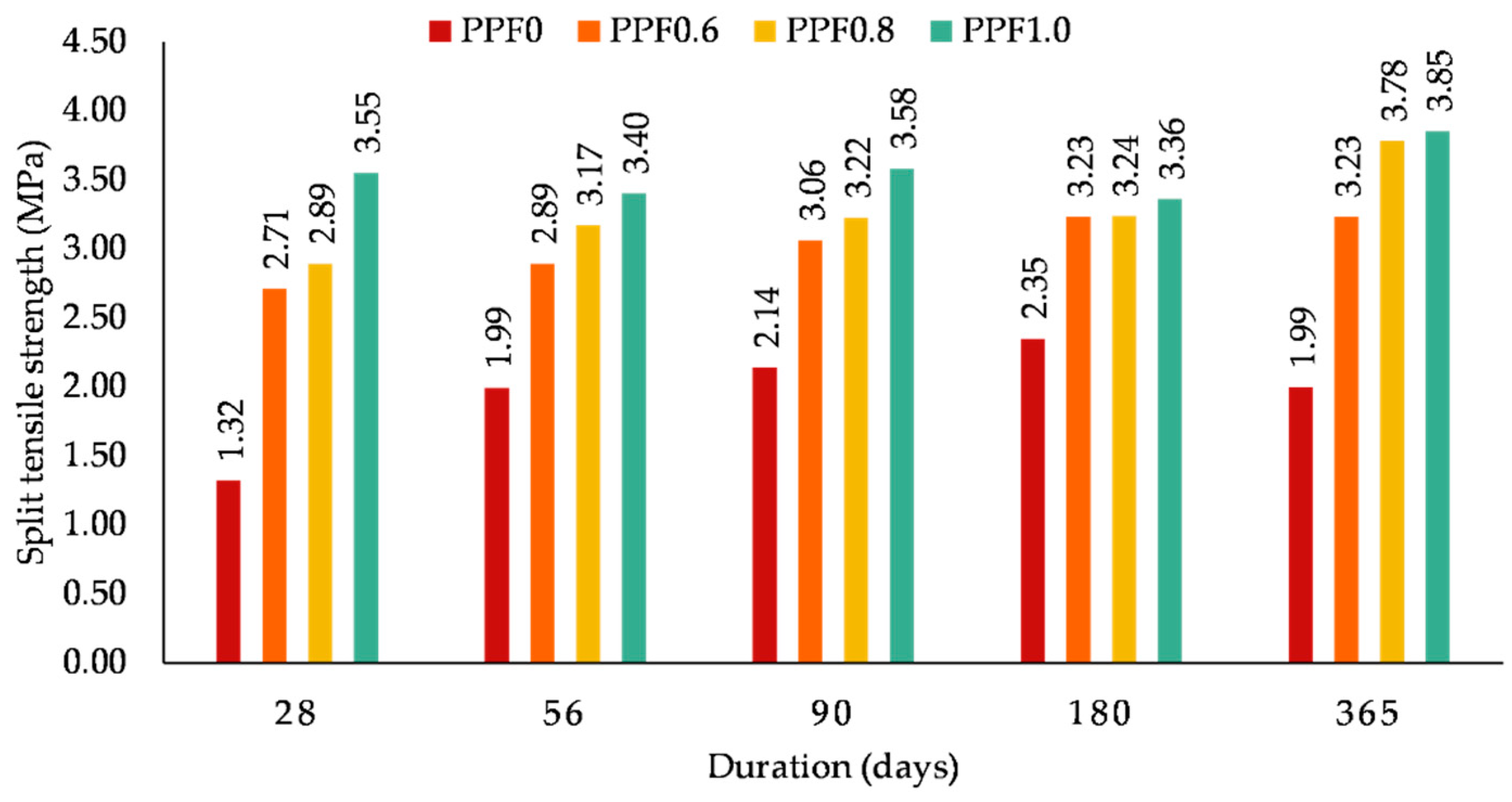
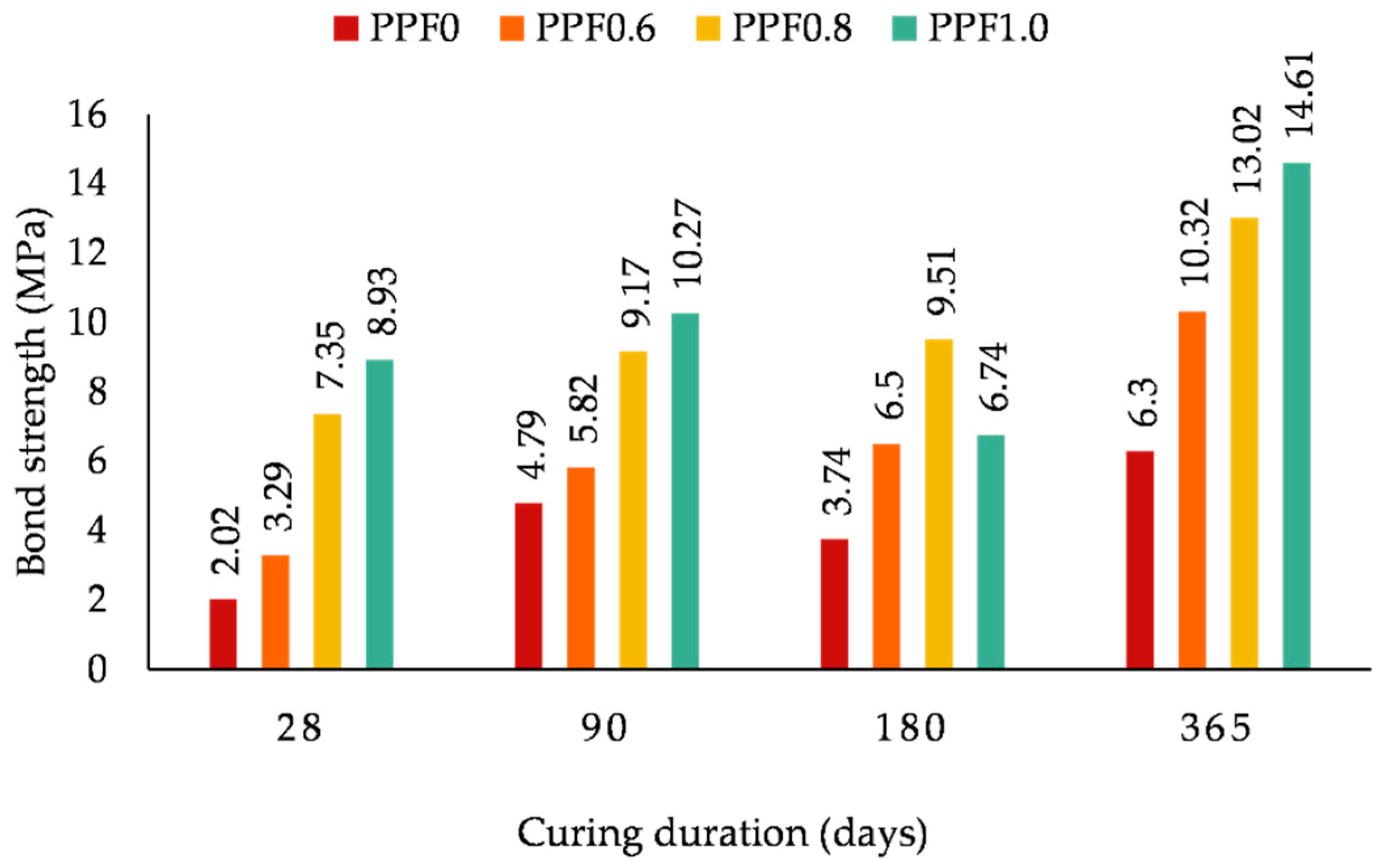
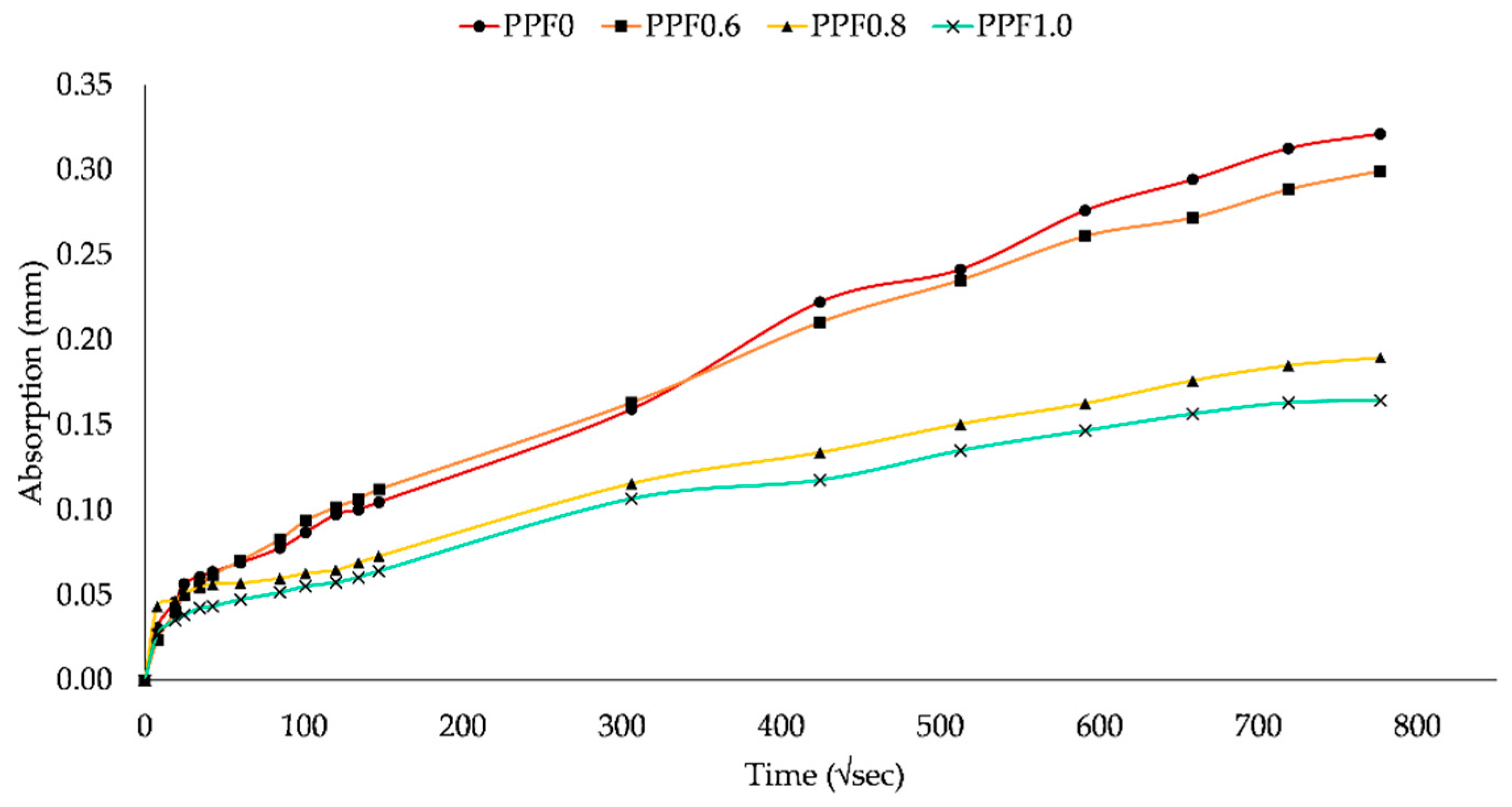

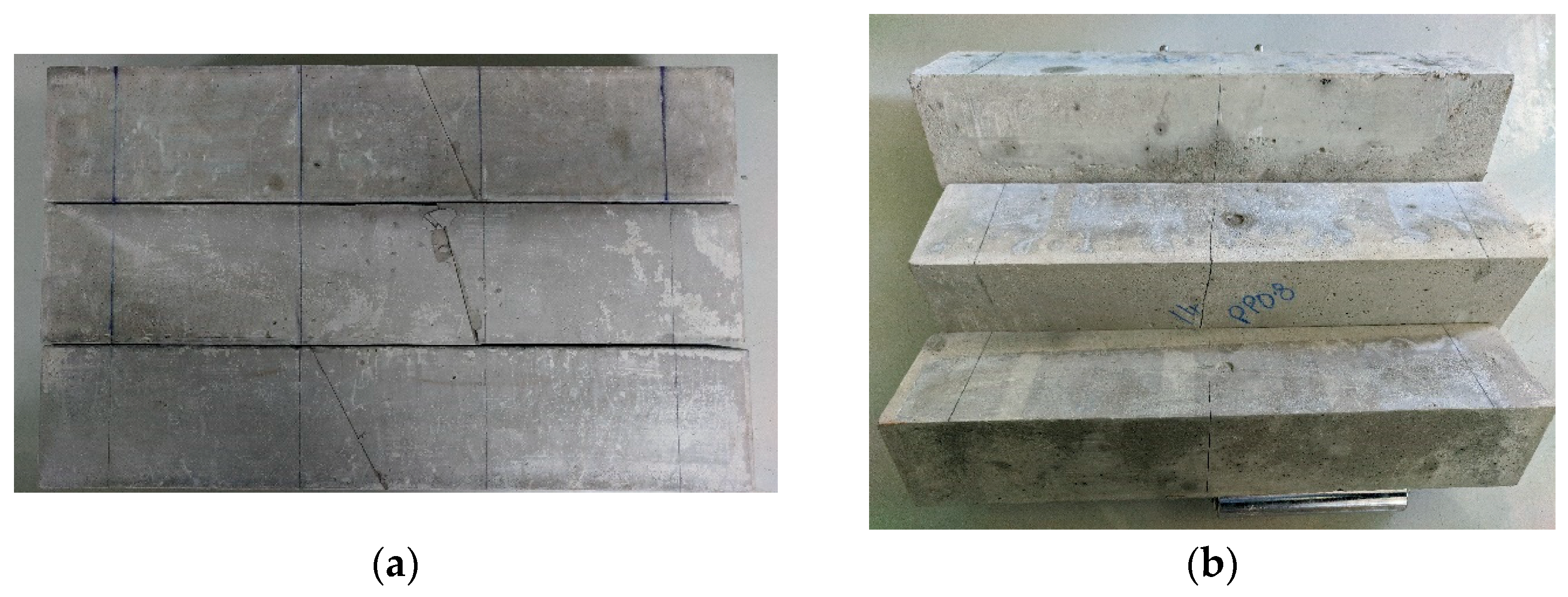

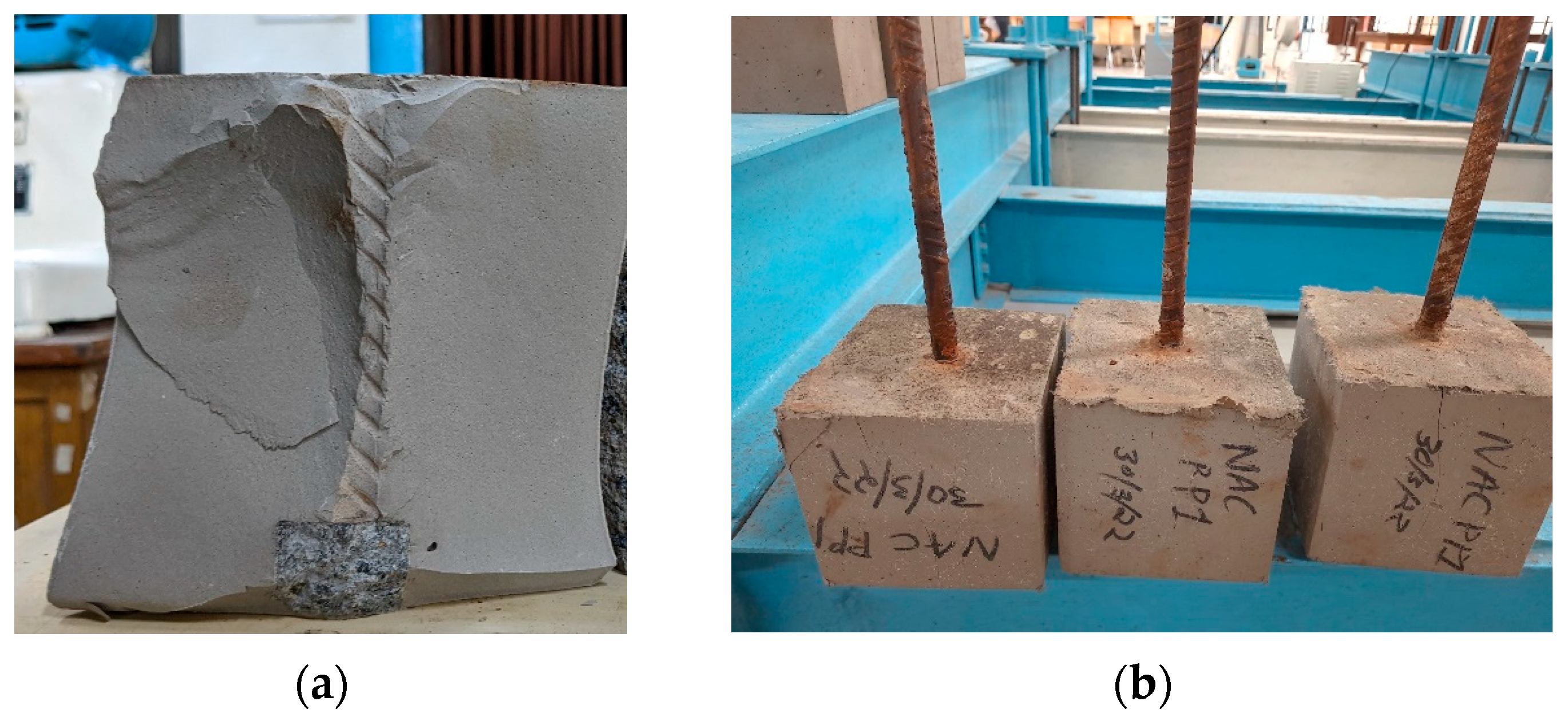
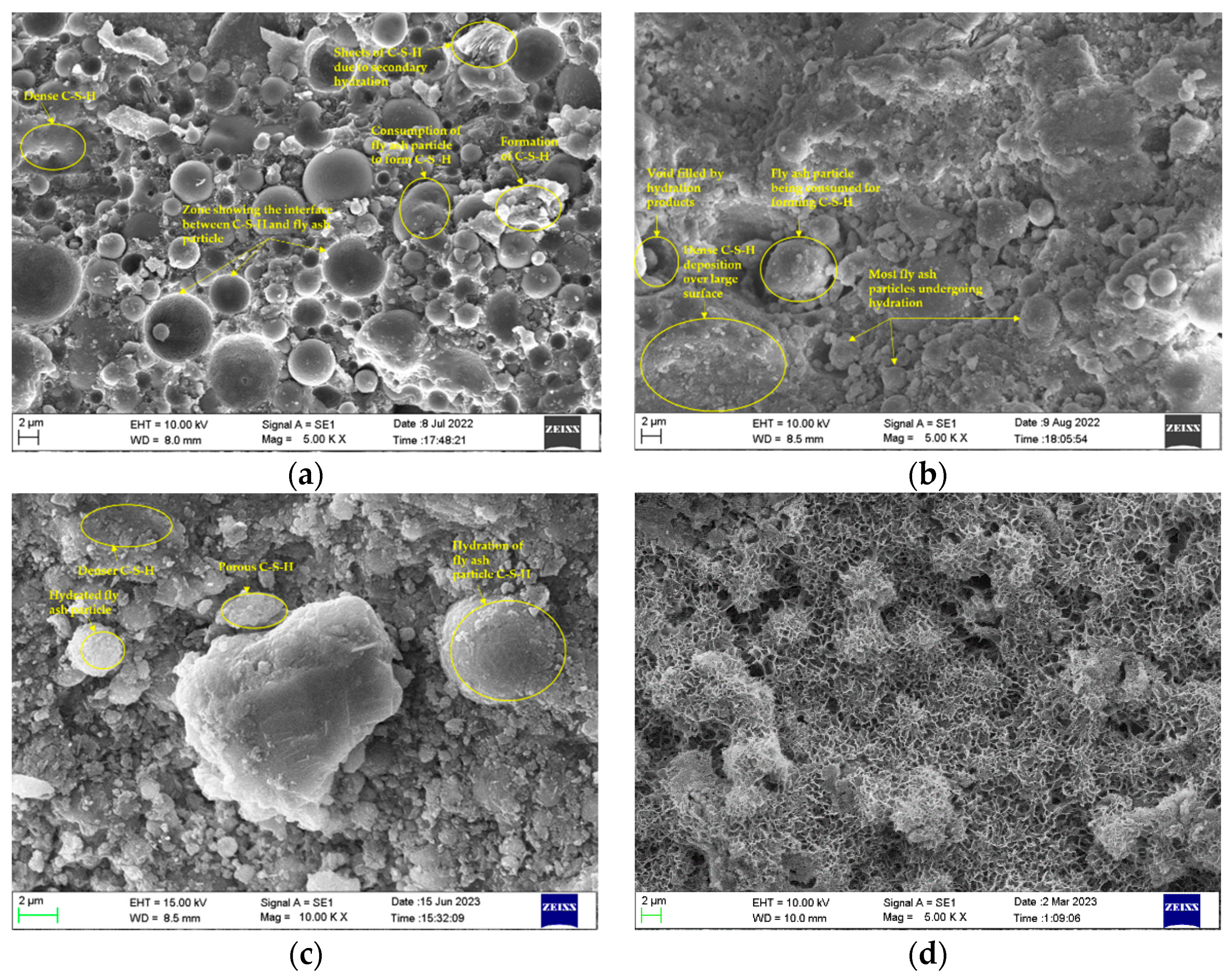
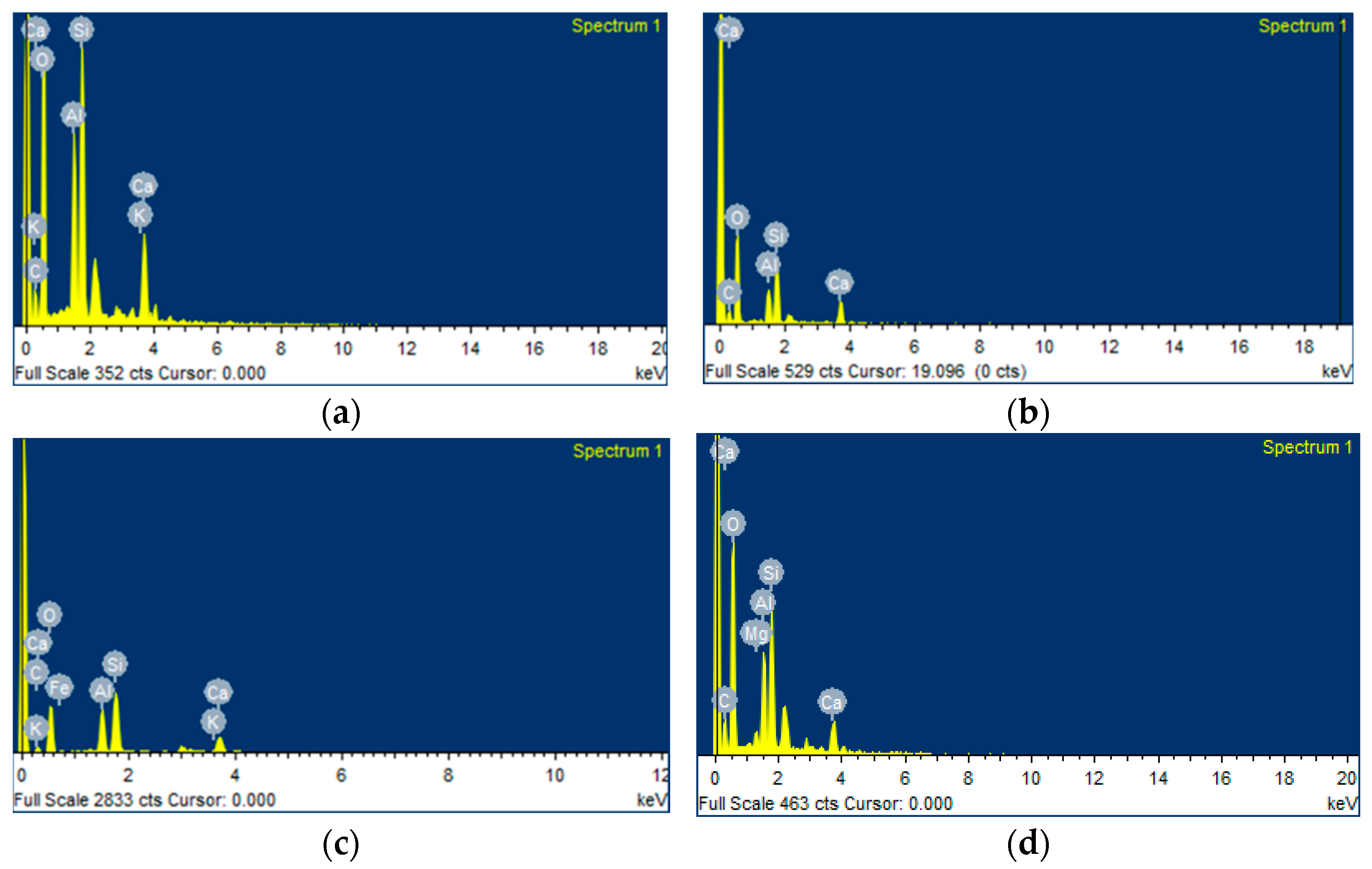
| Material | Particulars | Obtained Results | Reference Code | Acceptable Limit | Conformity |
|---|---|---|---|---|---|
| OPC 43 | Fineness dry sieve (90 µm) | 7.2% | IS 4031-1 [54] | <10% | √ |
| Normal consistency | @ 30% | IS 4031-4 [55] | - | √ | |
| Specific gravity | 3.15 | IS 4031-11 [56] | 2.9–3.15 | √ | |
| Setting time (min) | IS 4031-5 [57] | √ | |||
| Initial | 200 min | 30 min (min) | |||
| Final | 295 min | 600 min (max) | |||
| Compressive strength (MPa) | IS 4031-6 [58] | √ | |||
| 72 ± 1 h | 29.09 | 23 | |||
| 168 ± 2 h | 35.11 | 33 | |||
| 672 ± 4 h | 44.14 | 43 | |||
| F-FA | Fineness # | 12% | IS 1727-1967 [59] | 34% [60] | √ |
| Specific gravity | 2.10 | - | √ | ||
| Consistency | 31% | IS 1727-1967 [55,59] | - | √ | |
| Initial setting time Final setting time | 285 min 320 min | IS 1727-1967 [57,59] | - | √ | |
| Compressive strength (MPa) | 47.03 | IS 1727-1967 [59] | √ | ||
| Compressive strength (MPa) for 80:20 (OPC: F-FA) | 49.6 | - | √ | ||
| PAI * | 1.054 | - | √ |
| Chemical Composition | % By Mass |
|---|---|
| SiO2 | 61.18 |
| Al2O3 | 24.98 |
| Fe2O3 | 4.47 |
| CaO | 3.08 |
| MgO | 1.77 |
| K2O | 0.94 |
| SO3 | 0.31 |
| Na2O | 0.28 |
| Cl | 0.005 |
| LoA | 0.20 |
| Mix Designation | OPC | F-FA | w/b Ratio | Superplasticizer | PPF (%) |
|---|---|---|---|---|---|
| PPF0 | 325 | 1300 | 0.14–0.16 | 6.5 | 0 |
| PPF0.6 | 325 | 1300 | 0.14–0.16 | 6.5 | 0.6 |
| PPF0.8 | 325 | 1300 | 0.14–0.16 | 6.5 | 0.8 |
| PPF1.0 | 325 | 1300 | 0.14–0.16 | 6.5 | 1.0 |
| Test | IS Code | Sample Form | Size (mm) | Total No. |
|---|---|---|---|---|
| Compressive strength | IS 516: 1959 [61] | Cube | 100 × 100 × 100 | 112 |
| UPV | IS 516 (Part 5): 2018 [62] | |||
| Flexural strength | IS 516: 1959 [61] | Prism | 500 × 100 × 100 | 72 |
| Splitting tensile strength | IS 5816: 1999 [63] | Cylinder | 150 d × 300 h | 60 |
| Pull-out strength | IS: 2770 Part-1 1967 [64] | Cube | 150 × 150 × 150 | 48 |
| Sorptivity | ASTM:1585 [65] | Cylinder | 100 d × 50 h | 12 |
| Mix Designation | Initial Absorption Rate (×10−3 mm/√s) | Secondary Absorption Rate (×10−3 mm/√s) |
|---|---|---|
| PPF0 | 0.42 | 0.34 |
| PPF0.6 | 0.58 | 0.28 |
| PPF0.8 | 0.30 | 0.16 |
| PPF1.0 | 0.23 | 0.15 |
| Elements in Weight % | Ca | Si | Al | Ca/Si | Ca/Al | Ca/(Si + Al) | Al/Si |
|---|---|---|---|---|---|---|---|
| 28 days | 7.14 | 11.68 | 6.75 | 0.61 | 1.05 | 0.38 | 0.57 |
| 90 days | 5.60 | 12.36 | 7.91 | 0.45 | 0.70 | 0.27 | 0.63 |
| One year | 4.20 | 11.40 | 7.17 | 0.36 | 0.58 | 0.22 | 0.62 |
| Three years | 4.44 | 13.02 | 6.84 | 0.34 | 0.64 | 0.22 | 0.52 |
Disclaimer/Publisher’s Note: The statements, opinions and data contained in all publications are solely those of the individual author(s) and contributor(s) and not of MDPI and/or the editor(s). MDPI and/or the editor(s) disclaim responsibility for any injury to people or property resulting from any ideas, methods, instructions or products referred to in the content. |
© 2023 by the authors. Licensee MDPI, Basel, Switzerland. This article is an open access article distributed under the terms and conditions of the Creative Commons Attribution (CC BY) license (https://creativecommons.org/licenses/by/4.0/).
Share and Cite
Kudva, L.P.; Nayak, G.; Shetty, K.K.; Sugandhini, H.K. Mechanical Properties of Fiber-Reinforced High-Volume Fly-Ash-Based Cement Composite—A Long-Term Study. Sustainability 2023, 15, 13128. https://doi.org/10.3390/su151713128
Kudva LP, Nayak G, Shetty KK, Sugandhini HK. Mechanical Properties of Fiber-Reinforced High-Volume Fly-Ash-Based Cement Composite—A Long-Term Study. Sustainability. 2023; 15(17):13128. https://doi.org/10.3390/su151713128
Chicago/Turabian StyleKudva, Laxman P., Gopinatha Nayak, Kiran K. Shetty, and H. K. Sugandhini. 2023. "Mechanical Properties of Fiber-Reinforced High-Volume Fly-Ash-Based Cement Composite—A Long-Term Study" Sustainability 15, no. 17: 13128. https://doi.org/10.3390/su151713128






